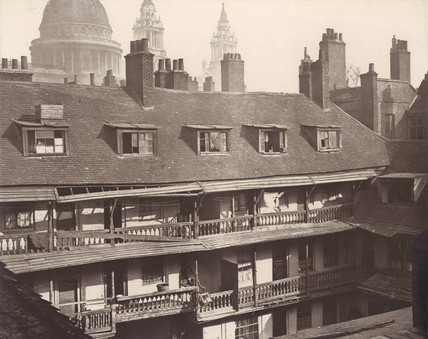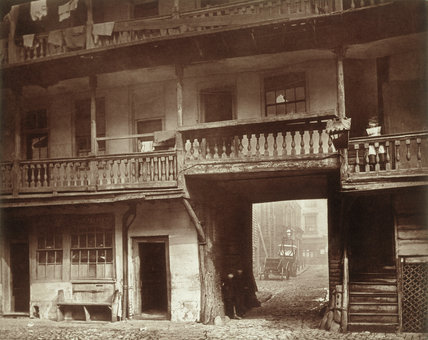London lost and found

I’ve been working on the sequel to Wild Boy – Wild Boy and the Black Terror. While the first book is set among London’s underworld - the rough fairgrounds, foul sewers and crumbling slums - the action of book 2 takes place where the rich folk lurk: the royal palaces, opera theatres and posh townhouses. One important scene, though, leads the detective and acrobat back to the slums and, specifically, to a place I’ve loved for years, even though I’ve only ever seen it in photographs.
It’s the Oxford Arms, a coaching inn that stood the shadow of St Paul’s Cathedral, on Warwick Lane. Until its demolition in 1877, the Oxford Arms was one of London’s last 17th century galleried inns. Apparently it survived the Great Fire in 1666, but I’m not sure how; I’ve rarely seen a more flammable-looking place. These photographs were taken by Henry Dixon months before the inn was demolished, and are linked to a gallery at the Museum of London where you can see more of Dixon's work.
Coaching inns were like our motels, where wagoners and stage-coachmen could stable their animals, rent rooms, and refresh themselves at the bar. Actors set up little stages in the yard, and passed around a top hats as they performed for weary travellers watching from the galleries.
Towards the end of the century, though, trains had replaced coaches for long distance trips. Hotels were built near railway stations, and the need for coaching inns was lost. Many were destroyed, but somehow the Oxford Arms survived. At least, just about survived. It is wonderfully derelict. Those decrepit doorways, windows without glass, roofs without tiles. The place makes me think of a witch’s grin – all crooked teeth and rotten gums. I’ve rarely felt such an urge to explore a building, or such frustration that I can't.
Records say that the Oxford Arms was abandoned when these photos were taken, but the images clearly show otherwise; that hanging washing and those ghostly figures staring from doorways.
An optimistic estate agent might have described the place as a fixer-upper, but it clearly needed more than a lick of paint. It needed to come down. Yet it’s demolition caused an outcry. Around that time, a lot of London’s historic buildings had been destroyed to make way for new streets or railway lines. City planners looked to sweep away relics of the medieval city and raise monuments to the modern age.
I’m all for that. Cities should change. They have to change. But we can’t just erase the past. That’s why I love the Oxford Arms. You see, the scheduled demolition of this diapidated inn led directly to the formation the Society for Photographing Relics of Old London (one of the most practical Victorian names I’ve come across) who commissioned these photographs, and others, to record the city that was vanishing around them. I like to think that, by taking Wild Boy and Clarissa there too, I’ve added a few lines of my own to this document of lost London.
Rob Lloyd Jones's Blog
- Rob Lloyd Jones's profile
- 65 followers




